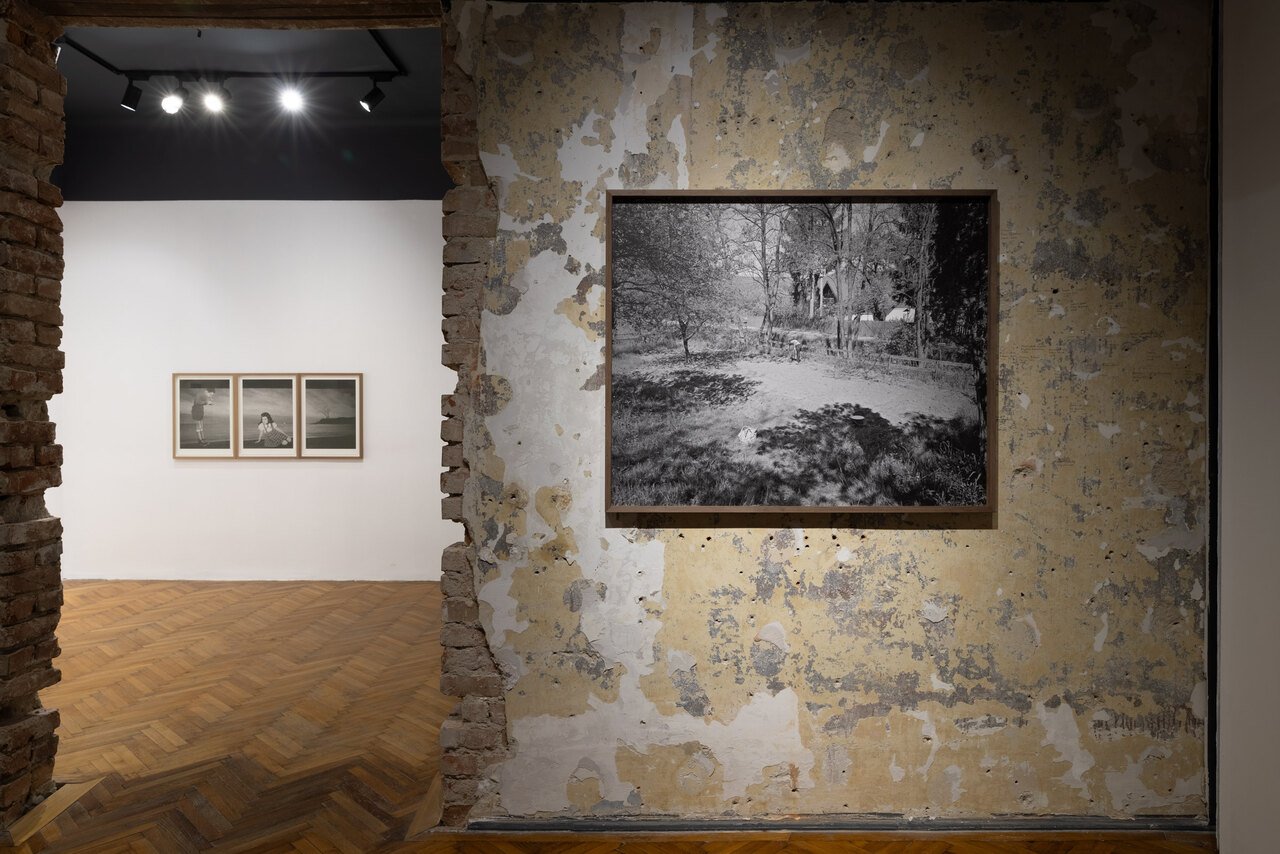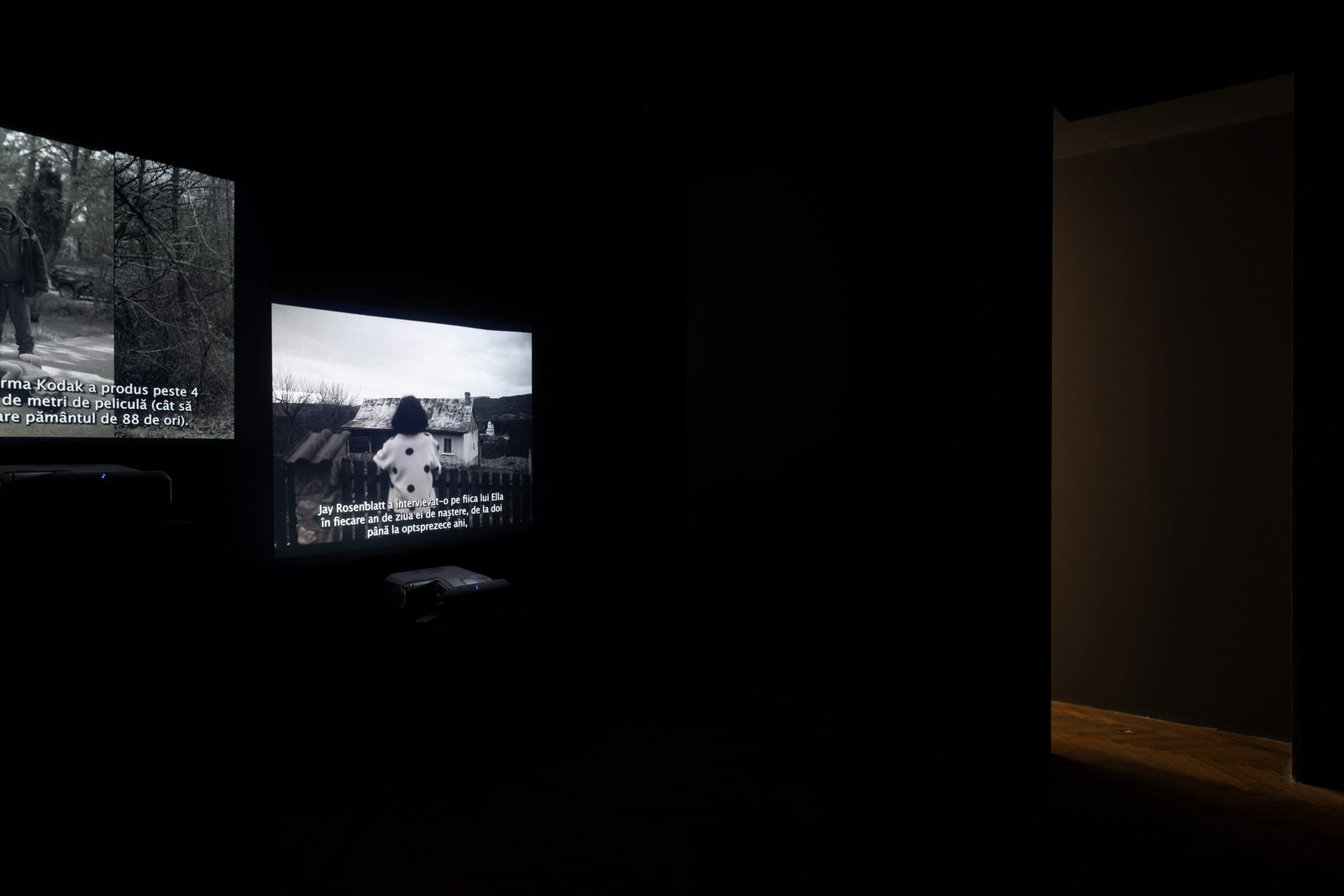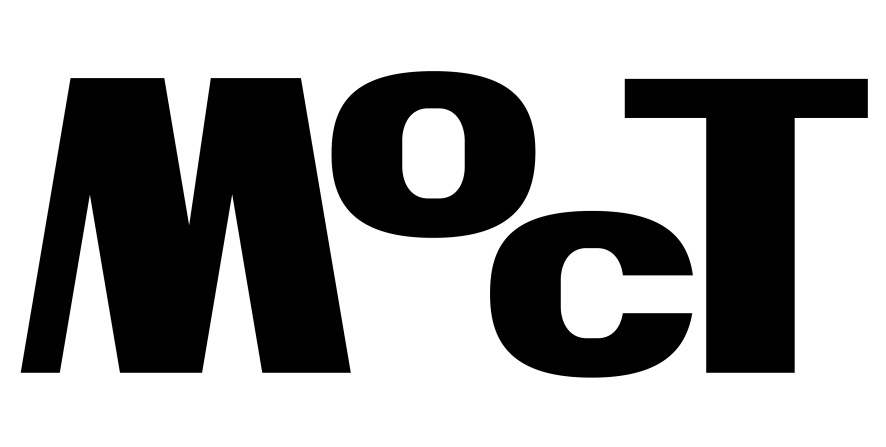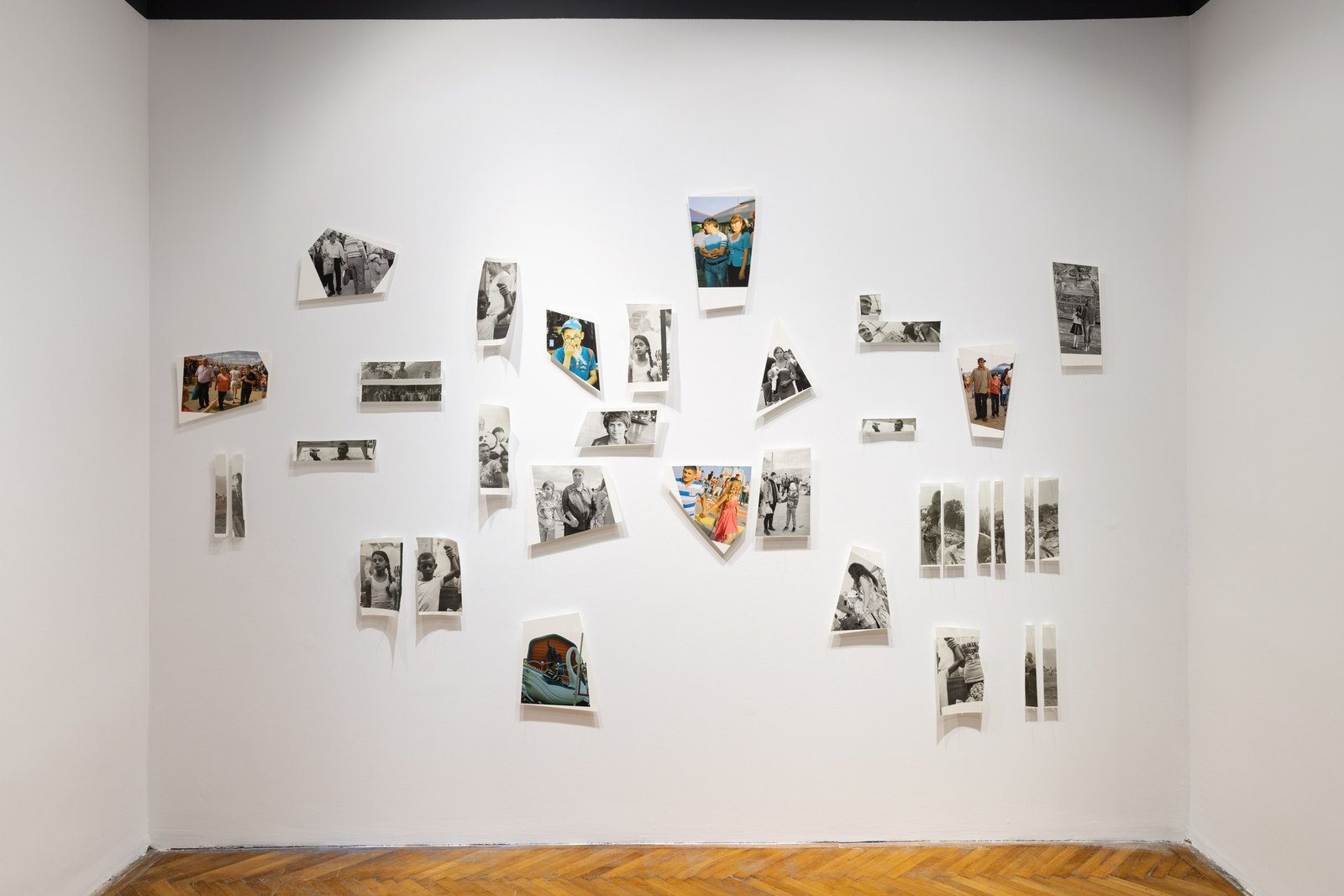Maximilian Lehner
Circles by Romanian photographer Nicu Ilfoveanu (1975) presents an indirect narrative of one of two “misfits” that reappear in his works. Not having been familiar with his previous series about Gigi and Valerică, it is the exhibition text that underscores their previous encounters, and draws me into looking for the connection between arbitrary discoveries of vernacular photography that the artist is obsessed with, and this exoticizing view on outsiders of society. Ilfoveanu also adds shots of his own daughter, “M”, in this exhibition, thereby merging his personal life with this long-term project – another element that I couldn’t find in his earlier series. Without directly mentioning a discourse of high and low, class, or even specifying who the two are and what their background is, the curator Anca Mihuleţ exemplifies with the photographs how such outdated boundaries might disappear.
In the entrance we see a bright, black and white photograph with some trees, a fence, and a person seemingly digging a hole in their garden under the glistening sun; the contrast of the image tuned down to grays and whites. In the first room we find an eclectic wall of cut-outs from luna park images, flanked by framed photos to both the left and right. On the left, we can see a girl who jumps between water puddles that illustrate quite literally the exhibition title. While all of this does not yet cohere, it is the last room – a black box – where two videos cycle in sequence, presenting different combinations of Ilfoveanu’s photos, tying everything together and making me reconsider the connection between these seemingly random works.


The artist has followed the above-mentioned characters, Gigi and Valerică, for about a decade, with only Gigi appearing in this show. Apart from the assumption that they live nearby, there’s little explanation about who they could be. I understand that Ilfoveanu himself also does not know too much about them. He met them in a remote place, near the Romanian town of Rădești, where he would go to photograph the landscape. Maybe it’s because of the randomness associated with their meeting in the first place the images seem to reflect some sort of indifference towards the characters. By that, I mean that Ilfoveanu does not try to carve out something special, or Other, but rather captures them as equals through the camera lens. In the text accompanying the exhibition, I learn that even though they have known each other for such a long time there haven’t been conversations with his two protagonists because they show up but don’t talk.
The main work of Circles is shown in a black box room. Two sequences of photographs are placed next to each other with digital projectors, their setup resembling slide projectors but presented at slightly different heights. We repeatedly see Gigi, he could be living on the streets, an aging hipster, or someone who works outdoors. Or maybe it is the nature and woods in the background that creates these images in my mind while at the same time remaining illegible enough to not fall into the trap of a cliché. I believe that the way Ilfoveanu approaches his subjects in Circles, as equals with the camera, is owed to his ongoing interest in vernacular photography.
To set the tone of Circles, the series of photos appear as slideshows with text, a female figure in a wedding dress pulls it up slightly as if she’s about to take a step, adding more drapes to the already ruffled textile while her head remains completely black – almost feeling like a horror movie from the 2000s. Each of the black-and-white shots, following one another in the two cycles, or circles, adds something to that feeling of an authentic yet aestheticized glimpse onto rural events: a photo against the sun with the hand of the photographer covering the backlight, creating the sort of breezy mood that only a spontaneous shot would create. And even though these two create a certain atmosphere, it is the photos of Gigi in his padded jacket that makes him the most present figure, accompanied by his dog, giving a fierce, direct look into the camera. Different image details, such as the camera position, or that some of the images have perfect light and gain qualities, with sharp contrast caused by beams of sunlight, hinting at the spontaneity under which the images were taken. While the landscape images or those with plants and grasses are generally executed with more detail, the whole collection of images that are connected as Circle 1 and Circle 2 carries this same lightness – that all these images might as well have been produced by chance.




The old projectors sometimes add noise to the installation as the old diascopes do, creating the idea of one slide advancing to the next. Only the fact that the projections don’t align neatly next to each other helps me to escape thinking of old-school art history lessons where images are compared diachronically to see similarities between them. I try to make connections between the two circles, once more alluding to my idea of the carousel projector. Each of the images have an overlaid text, one by the artist and the other by the curator. The discourse on photography that stems from the images builds up a similar tension that is also held up through the whole exhibition: between the well-reflected and theoretically-grounded art photography and the ordinary images made to remember places and people, in a sense, also representing the rural or “simple life” that the photographer seems to draw from a lot.
The texts connect in a loose way to the image; they are not descriptive but feel quite carefully selected. All of the sentences by both Mihuleţ and Ilfoveanu share the same tone, which is smart and full of references to photography theory and art history, while at the same time blending these thoughts with something colloquial and very ordinary. The references provided by Mihuleţ range from quotes from John Berger’s Ways of Seeing to an informal meeting between Andy Warhol and Bice Curiger, while Ilfoveanu’s comments focus on forgetting, different forms of anonymity, and all the other questions that come with vernacular photography: what are the moments that arbitrarily remain, what stays in these images? But Ilfoveanu also connects these philosophical questions back to the technical pragmatics about the postal service sending photographic postcards, or about which camera, printing device, or film was used to make the images.


By including his daughter in this exhibition, the artist inserts his personal life: his memories suddenly link to all the seemingly arbitrary collected moments, as well as to those from strangers. Here lies something on the paper (after a poem by Peter Handke) (2011-2023) is an image of three found photographs that have slowly started to fade. All elements are loosely connected, but truly circle around the idea of the ordinary photograph, without adding more thoughts on what it means that memories in photography cease to exist due to the material process, and fade as much as the psychological memory. It is interesting to see how the re-mediation – the photo of the fading photos – can point towards such a complex thought. Similarly, the wall next to it, which features an assemblage of photos taken at regional fun fairs, shows how a typology immediately creates a narrative. From the images cut in irregular shapes, printed in both color and black-and-white, we get a context that enables us to check further for the looks people exchange in those pictures or also with the viewer. How fast they turn into a series and lead us to reading visual information in a certain way demonstrates how powerful the role of the viewer is, in creating meaningful (or otherwise) narratives.
Vernacular photography, as well as the oddly shaped test prints that the wall collage is made from, embody types of photography not perfected or necessarily finished in their production processes, and are not made with conservation in mind. This precondition wonderfully demonstrates what Ilfoveanu does best in his work; creating a narration from various sources. Circles, for me, is a small introduction in to the world of Nicu Ilfoveanu; a documentary-like focus on fading images, aesthetics of everyday photography, and the refinement of this language through theory and art historical contextualization. I only noticed after viewing all the pieces how careful this exhibition has been put together, where nothing stands out as too spectacular but everything still adds up. In the end, this seems to be the quality of this show, to narrate how the erudite blends with the ordinary, how the thoughtfully composed can be excelled by the arbitrary, and how personal memory can be at once purposeful and incidental.

Artists: Nicu Ilfoveanu
Exhibition Title: Cercuri (Circles)
Curated by: Anca Mihuleţ
Venue: Galeria Posibilă
Place (Country/Location): Bucharest, Romania
Dates: 16.11.2023 – 10.02.2024
Photos by: Veronica Negrilă, courtesy of Galeria Posibilă, Bucharest

